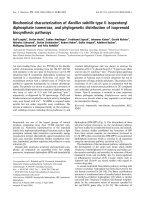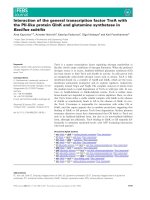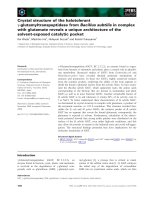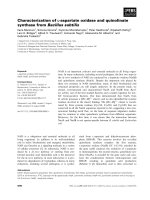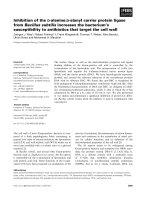Bioefficacy of bacillus subtilis against major pathogen of chilli colletotrichum capsici causing fruit rot of Chilli
Bạn đang xem bản rút gọn của tài liệu. Xem và tải ngay bản đầy đủ của tài liệu tại đây (360.04 KB, 6 trang )
Int.J.Curr.Microbiol.App.Sci (2018) 7(7): 2681-2686
International Journal of Current Microbiology and Applied Sciences
ISSN: 2319-7706 Volume 7 Number 07 (2018)
Journal homepage:
Original Research Article
/>
Bioefficacy of Bacillus subtilis against Major Pathogen of Chilli
Colletotrichum capsici Causing Fruit Rot of Chilli
K. Rajkumar1*, M.K. Naik1, Y.S. Amaresh1 and G. Chennappa2
1
2
Department of Plant Pathology, University of Agricultural Sciences, Raichur, India
Department of Processing and Food Engineering, University of Agricultural Sciences,
Raichur- 584104, India
*Corresponding author
ABSTRACT
Keywords
B. subtilis,
Biocontrol, PGPR,
Per cent inhibition,
C. capsici
Article Info
Accepted:
20 June 2018
Available Online:
10 July 2018
Bacillus subtilis is one of the potential PGPR and biocontrol agent against several plant
pathogens of important crop plants. In the present study thirty isolates of B. subtilis were
isolated from different rhizosphere soil samples from different parts of North Eastern
Karnataka region. All the rhizospheric isolates were rod shaped, positive for gram reaction,
endospore, oxidase, catalase, starch hydrolysis, negative for indole, KOH test and green
coloured colonies were grown on Hichrome Bacillus agar medium. All the thirty isolates
of B. subtilis were tested for their efficacy against C. capsici under in vitro. All the isolates
showed the varied level of inhibition of mycelial growth of C. capsici. Among different
isolates, BS16 showed maximum 63.42 per cent followed by BS 30 (57.40 %) inhibition
and minimum was 11.98 per cent in case of BS 24 compared to check (56 %). Biological
control is by using antimicrobial agents an attractive option which reduces the use of
chemicals in the management of diseases of chilli.
Introduction
Management of diseases of crop plants is
difficult due to arrival of new races of
pathogens. Chemical control is one of the
options for management but bears risk of soil
and water pollution. Pesticide residues have
detrimental effects on human, plant and soil
health and leads to development of mutant
resistant to pesticides (Gerhardson, 2002).
Hence, a biocontrol measure employing
antagonistic bacterial agents is an attractive
option (Han et al., 2005). Biocontrol is an
important strategy to reduce the use of
chemicals in disease management. Recently, a
considerable attention has been given to some
of the rhizobacteria which have positive
influence on the plant growth and health.
These are referred as Plant Growth Promoting
Rhizobacteria (PGPR) (Schippers, 1992;
Glick,
1995)
such
as
Azatobacter,
Pseudomonas, Azospirullum, Bacillus and
Brukholderia. Among the PGPRs, the
endospore forming, Bacillus subtilis is the one
which plays a major role in plant growth
promotion and biocontrol of pathogens (Glick,
1995). B. subtilis is a gram positive, rod
shaped bacteria with peritrichous flagella
2681
Int.J.Curr.Microbiol.App.Sci (2018) 7(7): 2681-2686
(Nakano and Hulett, 1997). The colony
morphology of the isolates exhibit a range
from flat to filamentous or branching (Wafula
et al., 2014), having either smooth or rough
colony with colour ranging from white to
cream. They grow well at pH ranging from 5 6.5 and temperature range of 25 to 35 oC
commonly found situation in soil. B. subtilis is
an endospore forming bacteria (Piggot and
Hilbert, 2004) which helps the organism to
persist in the environment until conditions
become favourable (Wafula et al., 2014). B.
subtilis shows strong positive results in the
methyl red test, oxidase test, litmus milk
reactions and lipid hydrolysis test. The
organism shows weakly positive for catalase
test, gelatin hydrolysis test and negative
results for citrate reduction, urease test,
arginine hydrolysis and fluorescence in King's
B medium (Montealegre et al., 2003).
Plant growth promotion and bio control of
plant pathogens by Bacillus spp. are achieved
by antibiosis, competition, mycoparasitism
(Korsten and De Jager, 1995) and induced
systemic resistance in host plant (Lemessa and
Zeller, 2007; Aliye et al., 2008; Ji et al.,
2008). These mechanisms might act singly or
in combinations by using extra-cellular lytic
enzymes viz, chitinase, amylase, protease,
lipase, xylanase and β 1, 3 glucanase which
exhibit antagonistic property because of
degradation of cell wall of fungi and bacteria
(Ramyabharathi and Raguchander, 2013), anti
microbial compounds such as HCN, H2S and
siderophore (Dinesh Singh et al., 2012) and
antibiotics such as subtilin, surfaction, iturin,
biofilm, difficiden, bacilomycin, bacilycin and
fengycin (Loeffler et al., 1990) which is
known to control a wide array of
phytopathogens such as fungi, bacteria and
nematodes. B. subtilis multiply rapidly,
occupy all available niches, absorb nutrients
and form biological screen around the root and
prevents breeding, growth, invasion of
harmful microorganisms (Timmusk et al.,
2005; Haggag and Timmusk, 2008).
However, the success of any biological control
programme
depends
on
our
clear
understanding about the biocontrol agent, their
ecology,
environments,
antagonistic
mechanisms and population dynamics in the
soil. The exact identity of strains to the species
level is the first step in realizing the potential
of any bio agent. Further, their study on the
diversity regarding rhizosphere niche of
different crops is a priority.
Materials and Methods
Collection and isolation of B. subtilis
isolates
Thirty isolates of B. subtilis were collected
from different rhizosphere soil samples of
chilli, chickpea, cotton, groundnut, onion,
marigold, mustard, niger, pegionpea, paddy,
sorghum, sunflower and wheat crops of
Bagalkot, Ballari, Raichur and Koppal parts of
North Eastern Karnataka agro ecosystem by
serial dilution and plate count technique on
nutrient agar medium and designated as BS-1
to BS-30. An isolate collected from UAS,
Dharwad (DBS-19) was used for comparison
to assess the biocontrol efficacy and PGPR
activity (Pankaj Kumar et al., 2012).
Bioefficacy of B. subtilis isolates against
Colletotrichum capsici
The isolates of B. subtilis were screened in
vitro for their antimicrobial properties against
major pathogen of chilli Colletotrichum
capsici causing fruit rot/ anthracnose of chilli
by using dual culture technique. The bio-agent
and the pathogen were inoculated side by side
in a single Petri plate containing solidified
PDA medium. Three replications were
maintained for each treatment with one control
by maintaining only pathogen. The plates
were incubated for 4 - 5 days at 28 ± 1 oC. The
mycelial diameter of pathogen was measured
in two directions and average was recorded
(Sumana and Devaki, 2013). Per cent
2682
Int.J.Curr.Microbiol.App.Sci (2018) 7(7): 2681-2686
inhibition of growth of test pathogen was
calculated using the following equation
(Vincent, 1927).
Where;
I = Per cent inhibition of mycelium
C = Growth of fungal mycelium in control.
T = Growth of fungal mycelium in treatment.
Results and Discussion
The bacterium was isolated from soil collected
from the rhizosphere soil of different crops
serial dilution and plate count technique. The
culture was morphologically identified based
on characters such as shape, texture of colony,
colony morphology and colour of colony.
Thirty B. subtilis isolates were evaluated in
vitro against C. capsici. All the isolates
recorded the varied level of inhibition of
mycelial growth of C. capsici. Among
different isolates, BS16 showed maximum
63.42 per cent followed by BS 30 (57.40 %)
inhibition and minimum was 11.98 per cent in
case of BS 24 compared to check (56 %)
(Table 1). Among 30 isolates of B. subtilis, ten
isolates were high; eleven isolates were
showed moderate performance and seven
isolates showed low performance (Plate 1)
(Fig. 1). Anand et al., (2010) reported that a
significantly highest inhibition of mycelial
growth of C. gloeosporiods causal agent of
anthracnose of pomegranate was noticed by
Pf4 isolate (81.43%) and least inhibition was
noticed in Pf8 (47.02%). The bacterial
antagonists such as B. subtilis isolate (BSCB4)
P. fluorescens isolate (ENPf1) and P.
chlororaphis isolate (PA23) were found to be
effective in inhibiting the mycelial growth of
C. cassicola causing stem blight of P. amarus
(Mathiyazhagan et al., 2003). Ashwini and
Shrividya (2012) strains of Bacillus spp. from
15 chilli rhizosphere soil were screened for
chitinolysis on chitin amended plates and their
involvement in the suppression of few
pathogens was determined. The selected
isolate showed broad spectrum antagonism
against
Alternaria
spp.
(55%),
C.
gloeosporioides (57%), P. capsici (62%), R.
solani (42%), F. solani (42%), F. oxysporum
(40%) and Verticillium spp. (36%).
Fig.1 In vitro bioefficacy of B. subtilis against C. capsici, the causal agent of anthracnose of chilli
2683
Int.J.Curr.Microbiol.App.Sci (2018) 7(7): 2681-2686
Plate.1 In vitro bioefficacy of B. subtilis isolates against C. capcisi, the causal agent of anthracnose of
chilli
Table.1 In vitro bioefficacy of B. subtilis against C. capsici, the causal agent of anthracnose of chilli
Sl. No.
1
2
3
4
5
6
7
8
9
10
11
12
13
14
15
16
17
18
19
20
21
22
23
24
25
26
27
28
29
30
32
32
Isolates
Per cent Inhibition
BS-1
40.82 (39.70)*
BS-2
27.34 (31.51)
BS-3
31.00 (33.00)
BS-4
40.44 (39.48)
BS-5
43.07 (41.00)
BS-6
11.98 (20.24)
BS-7
61.42 (51.58)
BS-8
31.08 (33.87)
BS-9
61.00 (51.00)
BS-10
18.72 (25.63)
BS-11
17.97(25.07)
BS-12
14.23 (22.15)
BS-13
35.34 (36.46)
BS-14
32.53 (34.76)
BS-15
18.83 (25.78)
BS-16
63.42 (52.77)
BS-17
14.05 (22.01)
BS-18
31.08 (33.87)
BS-19
61.20 (51.20)
BS-20
14.60 (22.45)
BS-21
12.73 (20.88)
BS-22
53.70 (47.11)
BS-23
26.21 (30.79)
BS-24
22.84 (28.54)
BS-25
18.87 (25.74)
BS-26
24.84 (32.54)
BS-27
56.48 (48.70)
BS-28
35.34 (36.46)
BS-29
32.08 (34.87)
BS-30
57.40 (49.24)
Check
56. 00 (48.00)
Control
00.00 (0.00)
S.Em ±
0.32
C.D at 1 %
0.91
>40%= High (H) = 11; 20-40%=Moderate (M =11
<20%=Low (L) =10; *Figures in the parentheses are arc sine values
2684
Remarks
H
M
M
H
H
L
H
M
H
L
L
L
M
M
L
H
L
M
H
L
L
H
M
M
L
M
H
M
M
H
H
L
Int.J.Curr.Microbiol.App.Sci (2018) 7(7): 2681-2686
In conclusion, B. subtilis exhibited sufficient
antibiosis capability due to its good inhibitory
performance against C. capsici. B. subtilis
strains with good antimicrobial properties
have been used as an alternative to chemical
pesticides in disease management strategy and
should be further studied under field
condition and possibly scaled-up for the
control of numerous phytopathogenic fungi
causing diseases and great yield losses.
References
Aliye, A. N., Fininsa, B. C. and Hiskias, Y.,
2008, Evaluation of rhizosphere
bacterial antagonists for their potential
to bioprotect potato (Solanum
tuberosum) against bacterial wilt
(Ralstonia solanacearum) Biol. Cont.,
47: 282-288.
Anand, M., Naik, M. K., Ramegowda, G. and
Devika Rani, G. S., 2010, Biocontrol
and plant growth promotion activity of
indigenous isolates of Pseudomonas
fluorescens. J. Mycopathol. Res.,
48(1): 45-50.
Ashwini, N. and Srividya, S., 2012, Study of
mycolytic enzymes of Bacillus spp.
against
Colletotrichum
gloeosporioides causing anthracnose
in Chilli. Acta Biologica Indica,
1(1):81-89.
Dinesh Singh, Yadav, D. K., Shweta, S. and
Upadhyay, B. K., 2012, Utilization of
plant growth promoting Bacillus
subtilis isolates for the management of
bacterial wilt incidence in tomato
caused by Ralstonia solanacearum
race 1 biovar 3. Indian Phytopath.,
65(1): 18-24.
Gerhardson, B., 2002, Biological substitutes
for
pesticides:
Trends
in
Biotechnology, 20: 338-343.
Glick, B. R., 1995, The enhancement of plant
growth promotion by free-living
bacteria. Can. J. Microbiol., 41: 9-17.
Haggag, W. M. and Timmusk, S., 2008,
Colonization of peanut roots by
biofilm-forming
Paenibacillus
polymyxa initiates biocontrol against
crown rot disease. J. Applied
Microbiol. 104: 961-969.
Ji, X., Yingping, L., Zheng, I. G. and Zhimei,
M., 2008, Biological control against
bacterial wilt and colonization of
mulberry by an endophytic Bacillus
subtilis strain. FEMS. Microbiol.
Ecol., 65: 565-573.
Korsten, L. and De Jager, E. S., 1995, Mode
of action of Bacillus subtilis for
control of avocado post-harvest
pathogens. South African Avocado
Growers'
Association
Yearbook
18:124-130.
Lemessa, F. and Zeller, W., 2007, Screening
rhizobacteria for biological control of
Ralstonia solanacearum in Ethiopia.
Biological Control, 42:336-344.
Loeffler, W., Kratzer, W., Kremer, S., Kugler,
M., Petersen, F., Jung, G., Rapp, C.
and Tschen, J. S. M., 1990, Gegen
pilze wirksame antibiotika der
Bacillus subtilis - Gruppe. Forum
Mikrobiol., 3: 156 -163.
Mathiyazhagan, S., 2003, Studies on the soil
borne diseases of Phyllanthus amarus
(Scham and Thom) and their
management. M. Sc. (Agri.) Thesis,
Tamil Nadu Agric. Unvi., Coimbatore
(India).
Montealegre, J. R., Reyes, R., Pérez, L. M.,
Herrera, R., Silva, P., and Besoain, X.,
2003, Selection of bio antagonistic
bacteria to be used in biological
control of Rhizoctonia solani in
tomato. Electronic J. Biotechnol.,
6:34.
Nakano, M. and Hulett, M., 1997, Adaptation
of Bacillus subtilis to oxygen
limitation. Microbiol., 157( 1): 1-7.
Pankaj Kumar, Dubey, R. C. and
Maheshwari, D. K., 2012, Bacillus
2685
Int.J.Curr.Microbiol.App.Sci (2018) 7(7): 2681-2686
strains isolated from rhizosphere
showed plant growth promoting and
antagonistic
activity
against
phytopathogens. Asian J. Boil. Life
sci., 2(2): 56- 67.
Piggot, P. and Hilbert, D. (2004). Sporulation
of Bacillus subtilis. Current Opinion
in Microbiol., 7( 6):579-586.
Ramyabharathi, S. A. and Raguchander, T.,
2013, Induction of defence enzymes
and proteins in tomato plants by
Bacillus subtilis EPCO16 against
Fusarium oxysporum f. sp. lycopersici.
Madra. Agric. J., 100(2): 126-130.
Schippers,
B., 1992, Prospects
for
management
of
natural
suppressiveness to control soilborne
pathogens. In: biological control of
plant diseases, progress and challenges
for the future. Life Sciences. Tjamos,
E. C., Papavizas, G. C. and Cook, R. J.
(eds.). Plenum Press, New York,
USA. 230: 21-34.
Sumana, K. and Devaki, N. S., 2013, In vitro
evaluation of some bioagents against
tobacco wilt. J. Biopest., 5(1): 18-22.
Timmusk, S., Grantcharova, N. and Wagner,
E. G. H., 2005, Paenibacillus
polymyxa invades plant roots and
forms biofilms. Appl. Environ.
Microbiol., 11: 7292-7300.
Vincent, J. M., 1927, Distortion of fungal
hyphae in presence of certain
inhibitors. Nature, 159: 850.
Wafula, E. N., Johnson, K., Daniel, K., Anne,
M. and Romano, M., 2014, Isolation
and characterization of Bacillus
species from soil in Ngere tea
catchment area of Murang’a county,
Kenya. Int. J. Life Sci. Res., 2(3): 2735.
How to cite this article:
Rajkumar, K., M.K. Naik, Y.S. Amaresh and Chennappa, G. 2018. Bioefficacy of Bacillus
subtilis against Major Pathogen of Chilli Colletotrichum capsici Causing Fruit Rot of Chilli.
Int.J.Curr.Microbiol.App.Sci. 7(07): 2681-2686. doi: />
2686

